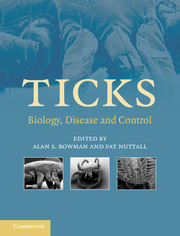Book contents
- Frontmatter
- Contents
- List of contributors
- Preface
- 1 Systematics and evolution of ticks with a list of valid genus and species names
- 2 The impact of tick ecology on pathogen transmission dynamics
- 3 Tick salivary glands: the physiology of tick water balance and their role in pathogen trafficking and transmission
- 4 Tick saliva: from pharmacology and biochemistry to transcriptome analysis and functional genomics
- 5 Tick toxins: perspectives on paralysis and other forms of toxicoses caused by ticks
- 6 Tick lectins and fibrinogen-related proteins
- 7 Endocrinology of tick development and reproduction
- 8 Factors that determine sperm precedence in ticks, spiders and insects: a comparative study
- 9 Tick immunobiology
- 10 Saliva-assisted transmission of tick-borne pathogens
- 11 Lyme borreliosis in Europe and North America
- 12 Viruses transmitted by ticks
- 13 Babesiosis of cattle
- 14 Theileria: life cycle stages associated with the ixodid tick vector
- 15 Characterization of the tick–pathogen–host interface of the tick-borne rickettsia Anaplasma marginale
- 16 Emerging and emergent tick-borne infections
- 17 Analysing and predicting the occurrence of ticks and tick-borne diseases using GIS
- 18 Acaricides for controlling ticks on cattle and the problem of acaricide resistance
- 19 Anti-tick vaccines
- 20 Anti-tick biological control agents: assessment and future perspectives
- 21 Pheromones and other semiochemicals of ticks and their use in tick control
- Index
- References
16 - Emerging and emergent tick-borne infections
Published online by Cambridge University Press: 21 August 2009
- Frontmatter
- Contents
- List of contributors
- Preface
- 1 Systematics and evolution of ticks with a list of valid genus and species names
- 2 The impact of tick ecology on pathogen transmission dynamics
- 3 Tick salivary glands: the physiology of tick water balance and their role in pathogen trafficking and transmission
- 4 Tick saliva: from pharmacology and biochemistry to transcriptome analysis and functional genomics
- 5 Tick toxins: perspectives on paralysis and other forms of toxicoses caused by ticks
- 6 Tick lectins and fibrinogen-related proteins
- 7 Endocrinology of tick development and reproduction
- 8 Factors that determine sperm precedence in ticks, spiders and insects: a comparative study
- 9 Tick immunobiology
- 10 Saliva-assisted transmission of tick-borne pathogens
- 11 Lyme borreliosis in Europe and North America
- 12 Viruses transmitted by ticks
- 13 Babesiosis of cattle
- 14 Theileria: life cycle stages associated with the ixodid tick vector
- 15 Characterization of the tick–pathogen–host interface of the tick-borne rickettsia Anaplasma marginale
- 16 Emerging and emergent tick-borne infections
- 17 Analysing and predicting the occurrence of ticks and tick-borne diseases using GIS
- 18 Acaricides for controlling ticks on cattle and the problem of acaricide resistance
- 19 Anti-tick vaccines
- 20 Anti-tick biological control agents: assessment and future perspectives
- 21 Pheromones and other semiochemicals of ticks and their use in tick control
- Index
- References
Summary
INTRODUCTION
Human activities continue to change the landscape vastly, altering faunal associations and thereby contact with arthropod vectors, producing circumstances that serve as the basis for the emergence of a vector-borne infection. However, few ‘emerging’ tick-borne infections are novel. Many (ehrlichiosis, babesiosis) have long been recognized as veterinary health problems. Some rickettsioses may be due to agents that were once thought to be tick endosymbionts. Others, such as the agents of bartonellosis, may form paratenic or dead-end associations with ticks. Some recently identified agents (deer tick virus, Borrelia lonestari) are ‘in search of an emerging disease’. Emergent epidemiological associations (Masters' disease) are in search of an agent. Finally, apparently well-characterized tick-borne infections, such as Rocky Mountain spotted fever, tularaemia and tick-borne encephalitis, remain neglected by researchers but retain the potential for resurgence. We briefly review the diversity of these infectious agents, identify aetiological enigmas that remain to be solved, and provide a reminder about ‘old friends’ that should not be forgotten in our pursuit of novelty. We suggest that newly recognized agents or tick–pathogen associations receive careful scrutiny before being declared as potential public health burdens.
REDISCOVERED, BETTER CHARACTERIZED, OR NEW?
Modern approaches to identifying and characterizing infectious agents, using nucleic acid amplification and molecular phylogenetic algorithms, are very powerful (Relman, 2002). However, there are fallacious assumptions that: (1) data accumulated by older (‘classical’) methods are not as precise and thus not to be trusted; and (2) a DNA or RNA sequence represents something novel if it does not match one that is already present in GenBank or other genetic information databases.
- Type
- Chapter
- Information
- TicksBiology, Disease and Control, pp. 344 - 376Publisher: Cambridge University PressPrint publication year: 2008
References
- 11
- Cited by



